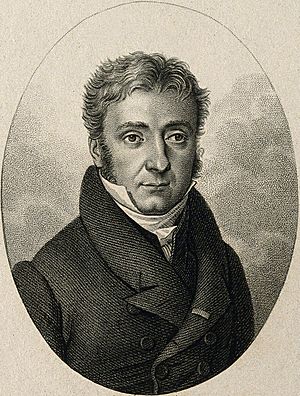Pierre Louis Dulong facts for kids
Quick facts for kids
Pierre Louis Dulong
|
|
|---|---|
 |
|
| Born | 12 February 1785 Rouen, France
|
| Died | 19 July 1838 (aged 53) Paris, France
|
| Known for | Dulong–Petit law |
Pierre Louis Dulong (born February 12, 1785 – died July 19, 1838) was a French physicist and chemist. He is best known for the Dulong–Petit law, which he created with his friend and fellow scientist, Alexis Thérèse Petit. Dulong was also praised by other scientists for his work on how steam behaves, how heat travels, and the specific heats of gases. He spent a lot of time studying how much heat different substances can hold and how gases expand.
Contents
Early Life and School
Dulong was born in Rouen, France. He was the only child in his family. When he was just four years old, he lost both of his parents. His aunt in Auxerre then raised him.
He went to school in Auxerre and later in Rouen. In 1801, he started studying at the École Polytechnique in Paris. However, he had to pause his studies because he wasn't well. He first studied medicine, but he later switched to science. He worked under the guidance of another famous scientist, Louis Jacques Thénard.
Amazing Discoveries
Dulong made many important discoveries in chemistry. He helped us understand:
- how different salts react together (in 1811)
- nitrous acid (in 1815)
- the oxides of phosphorus (in 1816)
- the oxides of nitrogen
- how metals can speed up chemical reactions, which is called catalysis (in 1823, with Thénard).
In 1811, Dulong also discovered a very dangerous chemical called nitrogen trichloride. During his experiments, he was seriously injured, losing three fingers and an eye. He kept this accident a secret. Because of this, another scientist, Humphry Davy, also got hurt while studying the same chemical, though his injuries were not as bad.
Scientists at the Royal Society in London recognized Dulong as an expert in many areas of physical science. They said he understood "almost every department of physical science."
Working with Alexis Petit
In 1815, Dulong started working with Alexis Thérèse Petit. They published a paper about how heat makes things expand. They continued to work together, studying how much heat different metals could hold.
In 1819, Dulong and Petit showed that the amount of heat needed to raise the temperature of a certain mass of a metal is related to its atomic mass. This discovery is now known as the Dulong–Petit law. Even though this law has been updated over time, it was very important for developing the periodic table and understanding atomic masses.
In 1818, the French Academy honored Dulong for his work that led to the Dulong–Petit law.
Later Career and Legacy
In 1820, Dulong became a professor of physics at the École Polytechnique, taking over from Petit, who retired due to poor health. Dulong studied how steam stretches, how to measure temperatures, and how elastic fluids behave. He also looked at how metals help certain gases combine. He was the first to accurately compare mercury and air temperature scales. In 1830, he became a foreign member of the Royal Swedish Academy of Sciences.
Dulong died in Paris from stomach cancer. His name is one of the 72 scientists carved into the Eiffel Tower. When he died, he was working on better ways to measure heat, a field called calorimetry. His last paper, published in the year he died, explored the heat released during chemical reactions.
A fellow physicist, Jules Jamin, described Dulong as a thoughtful and serious person. He worked slowly but very carefully, with great focus and courage. He was known for his exactness in science and his talent for designing and completing precise experiments.
Personal Life
Dulong married Emelie Augustine Riviere in 1803.
Some people thought Dulong was a bit distant. However, his close friends saw him as a calm and quiet person, not dull.
Dulong was very dedicated to science and showed great bravery in his experiments. For example, he once built a glass tube device on top of the Abbey of St. Genevieve tower. The tower was not very stable, and the chemicals he was using were dangerous. An explosion could have easily knocked over the tower and hurt the scientists, including Dulong. Despite the danger, Dulong led the experiment to completion.
Another example of his bravery was during his studies of nitrogen trichloride. Even after losing two fingers and an eye in his first experiments, Dulong continued to research this unknown substance. He suffered more injuries, but he still shared his findings with Sir Humphry Davy.
Death
Dulong spent most of his money on his scientific experiments. He often had very little money. Because of this, he did not leave much for his family when he died.
He is buried in Père Lachaise Cemetery. His monument was paid for by his fellow scientists.
Images for kids
See also
 In Spanish: Pierre Louis Dulong para niños
In Spanish: Pierre Louis Dulong para niños


